Transformación antropológica en mayores con diabetes tipo II a través del ejercicio: pilates y ejercicio aeróbico
DOI:
https://doi.org/10.24310/riccafd.2015.v4i1.6159Palabras clave:
diabetes tipo 2, personas mayores, actividad física, saludResumen
Las estadísticas muestran que 285 millones de personas sufren de Diabetes Tipo II, esto es el 6% de la población mundial adulta y 60 millones de personas en los Estados Unidos (10% de la población). De los 47 millones de habitantes que posee España, mas de 3 millones de personas sufren de diabetes (6.4%). En el año 2010 se gastaron más de 106 mil millones de dólares en salud por causa de la diabetes en los Estados Unidos. El ejercicio físico es una manera de evitar la diabetes en la población a través de: un mejor uso de la propia insulina producida por el cuerpo, de la quema de grasas, del control del peso corporal, del aumento de la fuerza muscular y del aumento en la densidad y calidad ósea. Una frecuencia semanal de 250 a 300 minutos de actividad física puede resultar de gran ayuda en el control de esta patología. La práctica de Pilates es un ejercicio que puede ser utilizado para lograr fácilmente un estado físico saludable. Puede ser realizado en el hogar, aprendiendo la técnica a través de la TV o de DVDs, es conveniente y sin costos. Además no presenta riesgos para las personas con diabetes tipo II, quienes son vulnerables por presentar una biomecánica disminuida en los miembros inferiores y/o una disfunción de la marcha.
Descargas
Métricas
Citas
Rippe, edited by Richard S. Irwin, James M. Manual of intensive care medicine (5th ed.). Philadelphia: Wolters Kluwer Health/Lippincott Williams & Wilkins, 2010.
American Diabetes Association. Diabetes Care “January 2010”, 2010. http://care.diabetesjournals.org/content/33/Supplement_1/S3.full
Gorsky M. The British National Health Service 1948-2008: A review of the historiography. Social History of Medicine. 2008; 21(3): 437-460.
Jakab S. Europe day: setting the scene. Intersectoral elements of the Health 2020 Strategy. 8th Global Conference on Health Promotion. Helsinki: WHO, 2013.
Jakab S. Better health for Europe. PINSAP Strategy and Programme. Barcenola: WHO, 2014.
Makura CB, Nirantharakumar K, Girling AJ, Saravanan P, Narendran P. Effects of physical activity on the development and progression of microvascular complications in type 1 diabetes: retrospective analysis of the DCCT study. BMC Endocr Disord. 2013; 13: 37.
Schellenberg ES, Dryden DM, Vandermeer B, Ha C, Korownyk C. Lifestyle interventions for patients with and at risk for type 2 diabetes: a systematic review and meta-analysis. Ann Intern Med. 2013; 159: 543–551.
American Diabetes Association. Standards of medical care in diabetes–2014. Diabetes Care. 2014; 37(Suppl): 1S14–80.
Castaneda C, Layne JE, Munoz-Orians L, Gordon PL, Walsmith J, Foldvari M, et al. A Randomized Controlled Trial of Resistance Exercise Training to Improve Glycemic Control in Older Adults With Type 2 Diabetes. Diabetes Care. 2002; 25: 2335–2341.
Evans WJ, Cyr-Campbell D. Nutrition,exercise, and healthy aging. J Am Diet AsSoc. 1997; 97: 632–638.
Kelley GA, Kelley KS, Tran ZV. Walking and resting blood pressure in adults: a meta-analysis. Prev Med. 2001; 33: 120–127.
Murphy MH, Nevill AM, Murtagh EM, Holder RL. The effect of walking on fitness, fatness and resting blood pressure: a meta-analysis of randomised, controlled trials. Prev Med. 2007; 44: 377–385.
Kelley GA, Kelley KS, Tran ZV. Walking and Non-HDL-C in adults: a meta-analysis of randomized controlled trials. Prev Cardiol. 2005; 8: 102–107.
Mahmuda F, Yasmin A, Mahi Uddin M, Begum R. Effect of Exercise in the Prevention and Management of Type 2 Diabetes Mellitus. Pulse. 2013; 6: 33-36.
Qiu S, Cai X, Schumann U, Velders M, Sun Z, Steinacker JM. Impact of Walking on Glycemic Control and Other Cardiovascular Risk Factors in Type 2 Diabetes: A Meta-Analysis. PLOS One. 2014; 9(10): e109767.
Pilates, JH. Your Health.Presentation. Dynamics, 1998
Levine B, Kaplanek B, Jaffe WL. Pilates training for use in rehabilitation after total hip and knee arthroplasty: a preliminary report. Clin Orthop Relat Res. 2009; 467(6):1468–1475.
Johnson EG, Larsen A, Ozawa H, Wilson CA and Kennedy KL. The effects of Pilates-based exercise on dynamic balance in healthy adults. Journal of Bodywork and Movement Therapies. 2007; 11(3): 238-242.
American Diabetes Association. Statistics about Diabetes. 2013. http://www.diabetes.org/diabetes-basics/statistics/?loc=superfooter
Bernardo LM. The effectiveness of Pilates training in healthy adults: An appraisal of the research literature. Journal of Bodywork and Movement Therapies.2007; 11: 106-110.
Cozen DM. Use of Pilates in foot and ankle rehabilitation. Sports Medicine and Arthroscopy Review. 2000; 8(4): 395-403.
Kloubec JA. Pilates for improvement of muscle endurance, flexibility, balance, and posture. Journal of Strength & Conditioning Research. 2010; 24(3): 661-667.
Latey P. The Pilates method: history and philosophy. Journal of Bodywork and Movement Therapies. 2001; 5(4): 275-282.
Smith K and Smith E. Integrating Pilates-based core strengthening into older adult fitness programs implications for practice. Topics in Geriatric Rehabilitation. 2005; 21(1): 17-67.
Babiyigit G., Ozdemir RA, Evin R, Irez SG, Korkusuz F. Integrating Pilates exercise program for 65+ year-old women to reduce falls. Journal of Sport Science and Medicine. 2011; 10: 105-11.
Di Lorenzo MD, Cameron C, Bruno V, Valuria DB, Carlo C. In preparation for the international symposium on obesity in the elderly. Ageing Health. 2006; 2:47-51.
Irez GB, Ozdemir RA, Evin R., Irez SK, Korkusuz, F. Integrating Pilates exercise into an exercise program for 65+ year-old women to reduce falls. Journal of Sport Science and Medicine 2011; 10: 105-111.
Hsiao-Wechsler, ET. Biomechanical and age-related differences in balance recovery using the tether-release method. Journal of Electromyography and Kinesiology. 2008;18(2): 179-187.
Tumiati R, Mazzoni G, Crisafulli E, Serri B, Beneventi C, Lorenzi CM, et al. Home-centred physical fitness programme in morbidly obese individuals: a randomized controlled trial. Clinical Rehabilitation. 2008; 22: 940-950.
Fleg JL, Morrell CH, Bos AG, Brant LJ, Talbot LA, Wright JG, et al. Accelerated Longitudinal Decline of Aerobic Capacity in Healthy Older Adults. Circulation. 2005; 112: 674-682.
Kosti? R, Panteli? S, Uzunovi? S, Djuraskovic R. A comparative analysis of the indicators of the functional fitness of the elderly. Facta Univ Ser Phys Educ Sport. 2011;9(2):161–171.
Martin PE, Morgan DW. Biomechanical considerations for economical walking and running. Med Sci Sports Exerc. 1992;24(4):467–474.
Thomas N, Alder E, Leese GP. Barriers to physical activity in patients with diabetes. Postgrad Med J.2004; 80: 287–291.
Descargas
Publicado
Cómo citar
Número
Sección
Licencia
Todos los contenidos publicados en Revista Iberoamericana de Ciencias de la Actividad Física y el Deporte están sujetos a la licencia Creative Commons Reconocimento-NoComercia-Compartirigual 4.0 cuyo texto completo puede consultar en <http://creativecommons.org/licenses/by-nc-sa/4.0>

Se pueden copiar, usar, difundir, transmitir y exponer públicamente, siempre que:
- Se cite la autoría y la fuente original de su publicación (revista, editorial y URL de la obra).
- No se usen para fines comerciales.
- Se mencione la existencia y especificaciones de esta licencia de uso.
Los derechos de autor son de dos clases: derechos morales y derechos patrimoniales. Los derechos morales son prerrogativas perpetuas, irrenunciables, intransferibles, inalienables, inembargables e imprescriptibles.
De acuerdo con la legislación de derechos de autor, Revista Iberoamericana de Ciencias de la Actividad Física y el Deporte reconoce y respeta el derecho moral de los autores/as, así como la titularidad del derecho patrimonial, el cual será cedido a la Universidad de Málaga para su difusión en acceso abierto.
Los derechos patrimoniales, se refieren a los beneficios que se obtienen por el uso o divulgación de las obras. Revista Iberoamericana de Ciencias de la Actividad Física y el Deporte se publica en open access y queda autorizada en exclusiva para realizar u autorizar por cualquier medio el uso, distribución, divulgación, reproducción, adaptación, traducción o transformación de la obra.
Es responsabilidad de los autores/as obtener los permisos necesarios de las imágenes que están sujetas a derechos de autor.






.png)








9.png)
